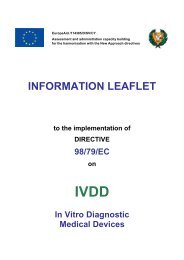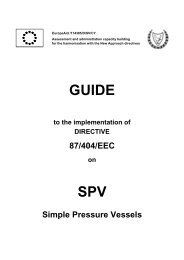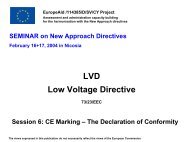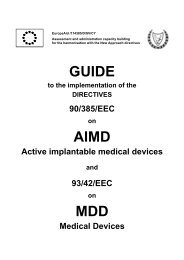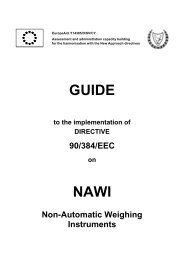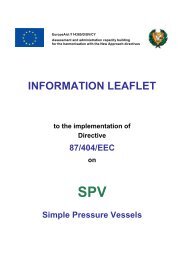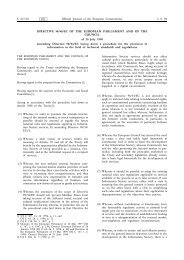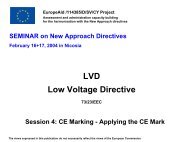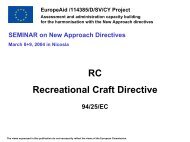Atex guidelines
Atex guidelines
Atex guidelines
Create successful ePaper yourself
Turn your PDF publications into a flip-book with our unique Google optimized e-Paper software.
-58-1.2.7. Protection against other hazards Equipment and protective systems must be so designed andmanufactured as to:(a) avoid physical injury or other harm which might be caused by direct or indirect contact;(b) assure that surface temperatures of accessible parts or radiation which would cause a danger, arenot produced;(c) eliminate non-electrical dangers which are revealed by experience;(d) assure that foreseeable conditions of overload shall not give rise to dangerous situations.Where, for equipment and protective systems, the risks referred to in this paragraph are wholly orpartly covered by other Community Directives, this Directive shall not apply or shall cease to applyin the case of such equipment and protective systems and of such risks upon application of thosespecific Directives.1.2.8. Overloading of equipmentDangerous overloading of equipment must be prevented at the design stage by means of integratedmeasurement, regulation and control devices, such as over-current cut-off switches, temperaturelimiters, differential pressure switches, flowmeters, time-lag relays, overspeed monitors and/orsimilar types of monitoring devices.1.2.9. Flameproof enclosure systemsIf parts which can ignite an explosive atmosphere are placed in an enclosure, measures must be takento ensure that the enclosure withstands the pressure developed during an internal explosion of anexplosive mixture and prevents the transmission of the explosion to the explosive atmospheresurrounding the enclosure.1.3. Potential ignition sources1.3.1. Hazards arising from different ignition sourcesPotential ignition sources such as sparks, flames, electric arcs, high surface temperatures, acousticenergy, optical radiation, electromagnetic waves and other ignition sources must not occur.1.3.2. Hazards arising from static electricityElectrostatic charges capable of resulting in dangerous discharges must be prevented by means ofappropriate measures.1.3.3. Hazards arising from stray electric and leakage currentsStray electric and leakage currents in conductive equipment parts which could result in, for example,the occurrence of dangerous corrosion, overheating of surfaces or sparks capable of provoking anignition must be prevented.1.3.4. Hazards arising from overheatingOverheating caused by friction or impacts occurring, for example, between materials and parts incontact with each other while rotating or through the intrusion of foreign bodies must, as far aspossible, be prevented at the design stage.1.3.5. Hazards arising from pressure compensation operationsEquipment and protective systems must be so designed or fitted with integrated measuring,control and regulation devices that pressure compensations arising from them do not generate shockwaves or compressions which may cause ignition.



